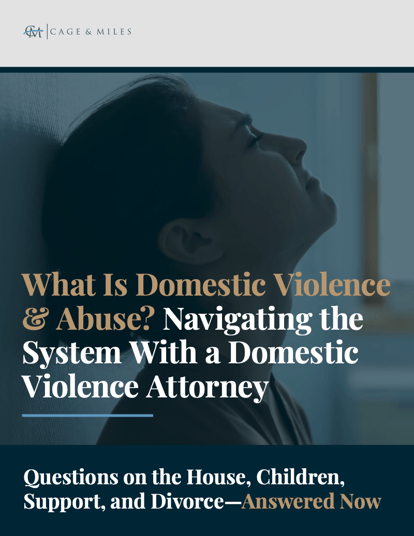California Domestic Violence Attorneys
Our team of seasoned domestic violence attorneys can help you take legal action with confidence, find clarity, and move forward.
- Home
- Law Practice Areas
- Family Law
- Domestic Violence
What is Domestic Violence?
Domestic violence is a difficult and emotional topic. As a result, most instances of domestic violence go unreported, even if the issue of violence is very relevant in most divorce and family law proceedings. Domestic violence is typically perpetrated in a pattern of or cycle of abuse, which is often used as a tool by the abuser to ensure the victim does not end the relationship. In addition, the victim is often in denial regarding the abuse due to the psychological effects of the cycle of violence.
It is important to clarify that domestic violence is not limited to physical abuse or domestic battery. Many forms of coercive control, verbal abuse, financial abuse, and disturbing the peace of another exist and are recognized by California family courts as domestic violence.
With years of professional experience helping hundreds of families throughout California, the domestic violence lawyers at Cage & Miles have the skills to help you create an informed plan to combat issues of domestic abuse. If you need help or information regarding restraining orders and protecting yourself, we can help.


Domestic Violence in California
California family courts can only assist with domestic violence which occurs between individuals with a specific familial or dating relationship.
This means that the victim and alleged abuser must be any of the following:
- A married couple
- An unmarried couple who have children together
- A couple who is divorced or separated
- Two people who are dating or engaged in a romantic relationship
- Two people who live together, or used to live together, in a non-roommate capacity
- Closely related people, such as a parent and child, grandparent and child, or siblings
Areas of Family Law
What Constitutes Domestic Violence?
Domestic violence can include physical harm, domestic battery, mental abuse, threats of physical harm, financial abuse, verbal abuse, coercive control, and other types of prohibited conduct defined below by the California Family Code:
- Placing a person in imminent danger of bodily harm
- Recklessly or intentionally causing harm
- Sexual assault, battery, molestation, or rape
- Attacking or harassing another individual
- Persisting, abusive, and unwanted contact
- Disturbing the peace of a victim
- Stalking or ignoring the terms of a restraining order
That’s why we put together this free guide — "What Is Domestic Violence & Abuse? Navigating the System With a Domestic Violence Attorney" — detailing the ins and outs of navigating domestic violence cases in California. Download the guide now to learn information that will prove essential to your case.

How to Get Domestic Violence Help
The first step abuse victims can take to get out of their situation is apply for a temporary restraining order, which is a temporary protective order that can be approved on the same day. It is crucial to speak with an experienced domestic abuse lawyer or local domestic violence advocate to discuss the best way to time and prepare for obtaining a domestic violence restraining order. Every victim of domestic violence needs a firm safety plan in place because leaving the abuser is the most dangerous time in the cycle of abuse for the victim.
Start Your Consultation Today
Our Attorney Reviews:
Family Law Blog:
PDODs and RFOs and MSAs, oh my! – Acronyms You Need to Know in Divorce Proceedings
| February 13, 2025
Are you going through a divorce? If so, have you noticed that everything is an acronym? Divorces are stressful enough, and trying to decipher the..
How Domestic Violence & Divorce Affect California Gun Rights
| November 13, 2023
While the United States Constitution guarantees its citizens “the right of the people to keep and bear Arms,” there are restrictions on this right. A..
Financial Abuse, Domestic Violence, & Divorce in California
| October 16, 2023
Domestic violence is defined broadly in California to include far more than mere physical abuse. While intentionally or recklessly causing — or..






